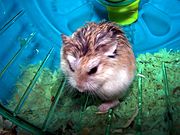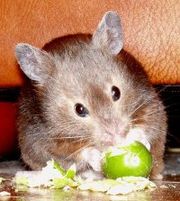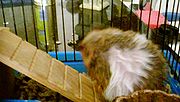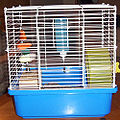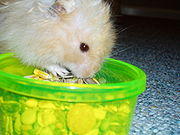
Hamster
About this schools Wikipedia selection
SOS Children has tried to make Wikipedia content more accessible by this schools selection. Sponsor a child to make a real difference.
| Hamster Temporal range: Middle Miocene - Recent |
|
|---|---|
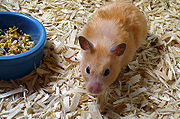 |
|
| A Syrian or Golden Hamster, Mesocricetus auratus | |
| Scientific classification | |
| Kingdom: | Animalia |
| Phylum: | Chordata |
| Class: | Mammalia |
| Order: | Rodentia |
| Suborder: | Myomorpha |
| Superfamily: | Muroidea |
| Family: | Cricetidae |
| Subfamily: | Cricetinae Fischer de Waldheim, 1817 |
| Genera | |
|
Mesocricetus |
|
Hamsters are rodents belonging to the subfamily Cricetinae. The subfamily contains about 18 species, classified in six or seven genera. Hamsters come in lots of different colours and shapes. Because they are easy to breed in captivity, hamsters are often used as lab animals and kept as pets in more economically developed countries. Over recent years they are very commonly used as pets for the common family.
Hamsters are crepuscular. In the wild, they burrow underground in the daylight to avoid being caught by predators. They are most active around dusk and dawn, which has led many people to mistake them for being nocturnal. In the wild they will eat any wheat, nuts and small bits of fruit and vegetables that they might find lying around on the ground, occasionally eating small insects such as small crickets or mealworms. Hamsters got their name from the German word "Hamstern" which means to hoard. They have elogated fur lined pouches on both sides of their heads which extends to their shoulders, which they stuff full of food to be brought back to the colony or eaten later.
Their diet contains a variety of foods both in the wild and when kept as a pets including dried food, berries and nuts, hard boiled or scrambled eggs, chicken and turkey. Fresh fruits and vegetables are also an integral part of their diet. Behaviour really depends on their environment, genetics, and interaction with people.
Characteristics
Hamsters are stout-bodied, with tails much shorter than body length and have small furry ears, short stocky legs, and wide feet. Their thick fur--which can be long or short--can be black, grey, white, brown, buff, yellow, "sapphire" and red depending on the species, or a mix of any of those colours; underparts are white to shades of gray and black. The Djhungarian hamster ( Phodopus campbelli) and the striped dwarf hamster ( Cricetulus barabensis) have a dark stripe down the middle of the back. Dwarf desert hamsters (genus Phodopus) are smallest, with bodies 5 to 10 cm (about 2 to 4 inches) long; the largest is the Common hamster ( Cricetus cricetus), measuring up to 34 cm long, not including a short tail of up to 6 cm. Usually it's not that long, and on a long haired hamster it's barely visible.
Habitat
Hamsters' northern range extends from central Europe through Siberia, Mongolia, and northern China to Korea. The southern portion of their range stretches from Syria to India. Throughout dry, open country they inhabit desert borders, vegetated sand dunes, shrubby and rocky foothills and plateaus, river valleys, and mountain steppes; some live among cultivated crops. Geographic distribution varies greatly between species. The common hamster, for example, is found from central Europe to western Siberia and northwestern China, but the golden hamster has been found only near a small town in northwestern Syria.
Diet
Hamsters are omnivorous. Their diet consists mostly of grains (such as corn) but also includes fresh fruit, roots such as carrots, green parts of plants, invertebrates, and other small animals. Hamsters carry food in their spacious cheek pouches to cache in the burrow. Hamsters in the Middle East have been known to hunt in packs to find insects for food.
Pet stores sell a large variety of treats that are suitable for hamsters. It is important not to give the hamster too many of these, especially ones that are high in fat or sugar, because they could lead to a hamster getting fat. Healthy alternatives include acorns and yogurt.
Most people can feed their hamster a lot of things from everyday food in their kitchen. Although the previously mentioned items are safe for hamsters to eat, not every hamster will enjoy the taste of all of those foods. It is also important to thoroughly wash fruits, vegetables and greens before feeding, as they can have traces of pesticides. Some foods to avoid giving hamsters are kidney beans, onion, garlic, large amounts of citrus fruit, and potato sprouts.Some hamsters also shouldn't eat iceberg lettuce.
Behaviour
Syrian hamsters are generally solitary; whereas, Dwarf hamsters can get along with others of the same species. They are primarily considered crepuscular and at one point were considered nocturnal as they are sometimes active all night. They are excellent diggers, constructing burrows with one or more entrances and with galleries that are connected to chambers for nesting, food storage, and other activities. They also like appropriate tunnels made by other mammals; the striped hairy-footed hamster (Phodopus sungorus), for instance, uses paths and burrows of the pika. None hibernate during winter, but some (mostly Syrian hamsters) experience periods of torpor lasting from a few days to several weeks. This probably means that conditions are too cold for them. Hamsters are known to stockpile large amounts of food. Hamsters dislike swimming but if forced to will inflate their cheek pouches with air to help them float.
Reproduction
Hamsters become fertile at different ages dependent on their species, but this can be from one month to three months of age. Male hamsters remain fertile for the rest of their lives, though females do not. Females are in heat approximately every four days.
Breeding season is from April to October, with two to five litters of 1 to 13 young being born after a gestation period of 16 to 22 days. Gestation lasts 16 to 18 days for Syrian hamsters, 18 to 21 days for the Russian hamsters, 21 to 23 days for Chinese hamsters and 23 to 30 for Roborovski Hamsters. The average litter for Syrians is about 7, but can be as great as 24, which is the maximum number of pups that can be contained in the uterus. Campbell's Dwarf Hamsters tend to have 4 to 8 in a litter but can have up to 14. Winter White Russian Dwarf Hamsters tend to have slightly smaller litters, as do Chinese and Roborovski hamsters.
Hamsters are born hairless and blind in a nest which the mother will have prepared in advance. She uses shredded material such as leaves in the wild but prefers cotton or toilet paper in captivity. After one week they begin to explore outside the nest. They are completely weaned after three weeks, or four for Roborovski Hamsters. Most breeders will sell the hamsters to shops when the hamsters are anywhere from two to eight months old.
Classification
Taxonomists currently disagree about the most appropriate placement of the subfamily Cricetinae within the superfamily Muroidea. Some place it in a family Cricetidae that also includes voles, lemmings, and New World rats and mice; others group all these into a large family called Muridae. Their evolutionary history is recorded by 15 extinct fossil genera and extends back 11.2 million to 16.4 million years to the Middle Miocene Epoch in Europe and North Africa; in Asia it extends 6 million to 11 million years. Four of the seven living genera include extinct species. One extinct hamster of Cricetus, for example, lived in North Africa during the Middle Miocene, but the only extant member of that genus is the common hamster of Eurasia.
- Subfamily Cricetinae
- Genus Allocricetulus
- Species A. curtatus - Mongolian Hamster
- Species A. eversmanni - Kazakh Hamster, also called Eversmann's Hamster
- Genus Cansumys
- Species C. canus - Gansu Hamster
- Genus Cricetulus
- Species C. alticola - Ladak Hamster
- Species C. barabensis, including "C. pseudogriseus" and "C. obscurus" - Chinese Striped Hamster, also called Chinese Hamster; Striped Dwarf Hamster
- Species C. griseus - Chinese Hamster
- Species C. kamensis - Tibetan Hamster
- Species C. longicaudatus - Long-tailed Hamster
- Species C. migratorius - Armenian Hamster, also called Migratory Grey Hamster; Grey Hamster; Grey Dwarf Hamster; Migratory Hamster
- Species C. sokolovi - Sokolov's Hamster
- Genus Cricetus
- Species C. cricetus - European Hamster, also called Common Hamster or Black-Bellied Field Hamster
- Genus Mesocricetus - Golden Hamsters
- Species M. auratus - Syrian Hamster, also called the Golden hamster or Teddy Bear hamster)
- Species M. brandti - Turkish hamster, also called Brandt's Hamster; Azerbaijani Hamster
- Species M. newtoni - Romanian Hamster
- Species M. raddei - Ciscaucasian Hamster
- Genus Phodopus - Dwarf Hamsters
- Species P. campbelli - Campbell's Russian Dwarf Hamster
- Species P. roborovskii - Roborovski Hamster, sometimes known as the Mongolian Hamster, causing confusion with Allocricetulus curtatus
- Species P. sungorus - Winter White Russian Dwarf Hamster
- Genus Tscherskia
- Species T. triton - Greater Long-tailed Hamster, also called Korean Hamster
- Genus Allocricetulus
Pet ownership
|
thumb|A Russian dwarf hamster |
The best-known species of hamster is the Syrian or Golden Hamster (Mesocricetus auratus), which is the type of hamster most commonly kept as a pet. It is also sometimes called a "fancy" hamster. Pet stores also have taken to calling them "honey bears," "panda bears," "black bears," "European black bears," "polar bears," "teddy bears," and "Dalmatian", depending on their coloration. There are also several variations, including long-haired varieties that grow hair several centimeters long and often require special care.
Other hamsters that are kept as pets are the four species of " dwarf hamster". Campbell's Dwarf Hamster ( Phodopus campbelli) is the most common of the four — they are also sometimes called "Russian Dwarfs"; however, many hamsters are from Russia, and so this ambiguous name does not distinguish them from other species appropriately. The coat of the Winter White Russian Dwarf Hamster (Phodopus sungorus) turns white during winter (when the hours of daylight decrease). The Roborovski Hamster (Phodopus roborovskii) is extremely small and fast. The Chinese Hamster (Cricetulus griseus), although not technically a true "dwarf hamster", is the only hamster with a prehensile tail (about 4cm long) - most hamsters have very short, non-prehensile tails.
Many breeders also show their hamsters and so breed towards producing a good healthy show hamster with a view to keeping one or two themselves so quality and temperament are of vital importance when planning the breeding. Although breeders of show hamsters specialise in breeding show hamsters, there are also owners who have bred their pet hamsters. These may be the result of a planned or unplanned pregnancy but the hamsters have usually been cared for well and handled regularly, so make very suitable pets. Buying a hamster directly from a breeder means that there is the opportunity to see the parents and know the dates of birth.
In Australia it is illegal to keep hamsters as pets as 'escapees' could breed in the wild and become 'feral' pest animals.
Housing
Hamsters can be kept both in cages and in vivaria, both of which are available in pet stores. Cages are easier to carry; their bars can be used for climbing. On the other hand, glass boxes keep hamsters from throwing litter out of their cages, provide a better view into the hamster's home, and create a quieter and more sheltered interior.
Despite the hamster’s small size, appropriate housing should always have a floor space of at least two square feet and a strong top because hamsters are surprisingly good climbers. Glass boxes must not be higher than their width to allow for a sufficient air circulation. Although smaller in size, dwarf hamsters often need more spacious housing than their larger relatives, at least 80cm by 40cm (2 feet by 4 feet) due to their high activity levels.
In the case of self-built dwellings, care should be taken to avoid materials that are dangerous to the animals. Plywood and wood from conifers is not suitable, because hamsters gnaw at their houses and both glue and resin are poisonous to them. Using standard water-soluble white wood glue to join pieces of solid wood, such as birch or beech wood, creates a safe environment for the hamster, although it may still chew through the wood. A purchased cage can be equipped with several intermediate levels, connected using stairs.
Hamsters do best in a well-lit room of constant, moderate temperature (18 to 26°C, 64 to 80 °F), in a place out of strong sunlight that could cause dangerous overheating. Dwarf hamsters like it a bit cooler.
The floor of a hamster's residence is generally covered with a layer of litter. Litter made from recycled paper or wood lacking aromatic oils (such as aspen) is healthiest - gnawing and eating cat litter can be deadly, and cedar, pine, or other softwood-based litters may contain phenols that can irritate a hamster's respiratory system, liver, and skin. There is also commercial bedding available, such as Carefresh and Megazorb.
-
Hamster Cage - Recoloured.jpg
An often-used type of hamster cage with tubes, too small for a full grown syrian.
-
Hamster Cages.JPG
Note that these standard tubes cannot be used at a steep incline with dwarf hamsters
Exercise and entertainment
Like all pets, hamsters need exercise and entertainment to maintain their physical and mental health. " Exercise wheels" allow hamsters to run full speed, and are a common fixture in pet hamsters' enclosures. Avoid using wheels with individual rungs or bars but rather select those with a solid base for comfortable running. This is because a hamster may trip and its legs may get caught on the rungs of the wheel while using it. Olive oil (which is harmless to a hamster if ingested) can be used to lubricate the axle of the exercise wheel to reduce friction and cut down on turning noises when in use. Other common objects are plastic balls or cars that the hamster can be placed in so that they can be supervised while exploring outside their cage. Lack of exercises for a hamster may cause it to suffer from paralysis, and the affected hamster will have a hunched over posture.
Hamsters are nest builders, so most owners supply strips of tissue or toilet paper so they may build a secure spot in a corner or in their "house". Avoid using newspapers as the ink on it might be ingested when the hamster chews on them. Also avoid bleached-white toilet paper. Hay is also a valuable building material for cozy hamster nests, but may pose the risk of having pesticides on it or sharp pieces that could cut or scratch the hamster. Therefore, select dry hay such as Timothy and use the softer, leafy parts of the hay rather than the stems. Sawdust made from pine, and cedar wood shavings are not suitable for nesting material as stated earlier. It is not advisable to use lint, as the hamster may consume it and the lint will block their intestinal passage. Fine chinchilla sand (not chinchilla dust because the powdery material will cause respiratory problems) can be given in an enclosed container. Hamsters enjoy rolling in the sand to keep their fur clean and dry.
Hamsters, like many rodents, are also gnawers, and must be supplied with appropriate materials for doing so; for example, an edible gnaw toy or an unpainted wooden block can be placed in the cage. Failure to do so can cause dental problems for the hamster, as the incisors, which grow continually, will become too long and cause discomfort and/or eating problems.
Food
Many hamsters tend to carry food from the source (by carrying it in their cheek pouches) and hoard it away in a cache hidden somewhere inside their container. Fresh vegetables and fruits, seeds, and insects like grasshoppers make up an important part of hamsters' natural diet. However, not all foods are suitable for hamsters and some, such as sweets made for humans or poisonous plants like the leaves of the tomato or rhubarb, are dangerous for hamsters. Citrus fruits such as oranges and lemons should never be fed to a hamster because their stomachs can not handle the acid. Iceburg lettuce has very little nutritional value and in excess can cause liver problems. Campbell's Dwarf Hamsters are susceptible to hereditary diabetes, and any hamster suffering from diabetes should not have high sugar foods, such as fruit and corn. Hamsters also love to eat sunflower seeds as treats!
In detail, the solid food components can be divided into three categories: dry, fresh, and animal food. Dry food generally makes up the bulk of a hamster's diet. Besides the standard rodent food sold in pet stores, most other kinds of seeds, kernels, and nuts can be given. Bird food like millet is a noteworthy alternative for small hamsters.
Health conditions
Relationships among hamsters
Neumann et al. (2006) conducted a molecular phylogenetic analysis of 12 of the above 17 species of hamster using DNA sequence from three genes: 12S rRNA, cytochrome b, and von Willebrand factor. They uncovered the following relationships:
- Phodopus group
The genus Phodopus was found to represent the earliest split among hamsters. Their analysis included both species. The results of another study (Lebedev et al., 2003) may suggest that Cricetulus kamensis (and presumably the related C. alticola) might belong to either this Phodopus group or hold a similar basal position.
- Mesocricetus group
The genus Mesocricetus also form a clade. Their analysis included all four species, with M. auratus and M. raddei forming one subclade and M. brandti and M. newtoni another.
- Remaining genera
The remaining genera of hamsters formed a third major clade. Two of the three sampled species within Cricetulus represent the earliest split. This clade contains Cricetulus barabensis (and presumably the related C. sokolovi) and Cricetulus longicaudatus.
- Miscellaneous
The remaining clade contains members of Allocricetulus, Tscherskia, Cricetus, and Cricetulus migratorius. Allocricetulus and Cricetus were sister taxa. Cricetulus migratorius was their next closest relative, and Tscherskia was basal.
Similar animals
Note that there are some rodents which are sometimes called "hamsters" that are not currently classified in the hamster subfamily Cricetinae. These include the Maned Hamster or Crested Hamster, which is really the Maned Rat (Lophiomys imhausi), although not nearly as marketable under that name. Others are the mouse-like hamsters (Calomyscus spp.), and the white-tailed rat (Mystromys albicaudatus).
